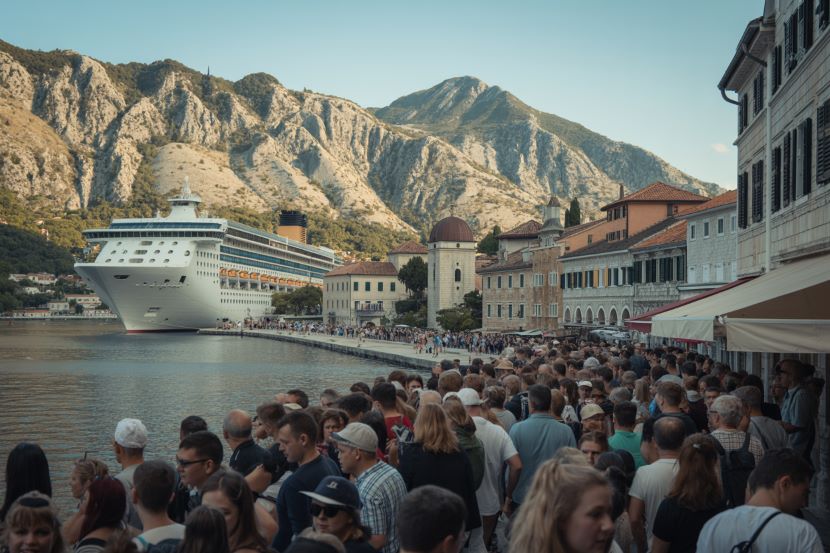Kotor Overwhelmed by Cruise Ship Tourists: A Coastal Town at Risk of Environmental Damage
Kotor, Montenegro faces overwhelming crowds due to the rising number of cruise ships docking daily, raising concerns about the environment and local infrastructure.
The picturesque town of Kotor, nestled on the Adriatic coast of Montenegro, is facing an overwhelming surge in cruise ship tourism, with hundreds of vessels docking daily. Known for its UNESCO World Heritage status, medieval architecture, and dramatic setting beneath the limestone cliffs of Mt. Loven, Kotor has long been a must-visit destination for travelers. However, the town’s charm is now under threat as it grapples with the strain of mass tourism.
Kotor’s narrow streets, quaint squares, and ancient Romanesque churches are being overrun by tourists, many of whom arrive on massive cruise ships. On one particularly busy day last August, 5,000 holidaymakers flooded into the town, adding to the town’s modest population of just 23,000 residents. This constant influx has raised serious concerns among both locals and environmentalists.
The Economic Impact of Cruise Tourism
Tourism has become a significant part of Montenegro’s economy, with cruise ships contributing a large portion of visitors. According to the Statistical Office of Montenegro, the country saw over 2.6 million visitors in 2024, with the majority of them coming from neighboring countries and regions, such as Serbia, Russia, Bosnia and Herzegovina, Turkey, and the UK.
While the economic benefits of tourism are undeniable, the costs are beginning to outweigh the rewards for Kotor. The once peaceful coastal town now faces overcrowded streets, overburdened infrastructure, and an overstretched local sewage system, which was never designed to handle such high volumes of tourists.
Environmental Concerns and Sustainable Tourism
The growing number of cruise ship arrivals has sparked fears about the environmental impact on the town and its marine ecosystem. The increase in tourism, particularly from cruise ships, has put significant pressure on Kotor’s natural resources, with rising concerns about pollution, waste management, and the preservation of the town’s cultural heritage.
Reports from the UN’s Global Environment Facility (GEF) Adriatic Project point out that while the increase in population in Montenegro may be modest, the surge in tourist numbers is causing significant stress on local infrastructure. The country’s sewage systems, in particular, are struggling to keep up with the rising demands, which poses a major challenge for the long-term sustainability of tourism in the region.
The marine ecosystem around Kotor, renowned for its crystal-clear waters and rich biodiversity, is also under threat. Cruise ships often discharge waste directly into the sea, exacerbating pollution levels and threatening the health of local wildlife. Local residents and environmentalists are calling for immediate action to address these growing concerns and ensure that Kotor remains a sustainable destination for future generations.
Calls for Sustainable Solutions
The situation in Kotor has led to calls for better regulation and management of cruise ship tourism. One suggestion that has been put forward is to increase the current €1 charge that cruise ship passengers pay to access the town, which is seen as insufficient given the massive number of visitors arriving daily. Some are advocating for higher entry fees or restrictions on the number of cruise ships allowed to dock at any given time.
Additionally, local authorities and tourism boards are exploring alternative measures to manage the environmental impact, such as developing eco-friendly infrastructure, improving waste management systems, and promoting sustainable tourism practices. This could include encouraging smaller-scale tourism options that focus on preserving Kotor’s natural beauty and historical sites, rather than catering to mass tourism.
What Travelers Can Do
For tourists planning to visit Kotor, there are several steps they can take to minimize their environmental impact and help protect this UNESCO World Heritage site:
- Opt for Land-Based Travel: Instead of arriving by cruise ship, consider visiting Kotor by bus, train, or private car to reduce the pressure on the town’s port and infrastructure.
- Travel During Off-Peak Times: If possible, avoid visiting during peak tourist seasons, particularly the summer months, when cruise ships are most active.
- Respect Local Communities: Be mindful of the local population and try to support small, locally owned businesses, which are often more sustainable.
- Adhere to Environmental Guidelines: Follow all guidelines regarding waste disposal and conservation efforts in Kotor, ensuring you leave the destination as you found it.
Conclusion
Kotor’s struggle with the overwhelming surge of cruise ship tourism highlights the delicate balance between economic growth and environmental sustainability. While tourism plays a crucial role in the region’s economy, there is an urgent need for better management and sustainable practices to preserve the town’s unique charm and ecological health.
As Kotor continues to grapple with the pressures of mass tourism, it is essential that both the local government and travelers work together to protect this historic gem of the Adriatic for future generations.
The post Kotor Overwhelmed by Cruise Ship Tourists: A Coastal Town at Risk of Environmental Damage appeared first on Travel and Tour World


Comments and Responses
Please login. Only community members can comment.